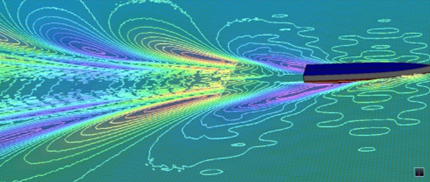Impact of Axe Bow Hull Shape on Patrol Ship Resistance, Freeboard, and Trim
Main Article Content
Abstract
Patrol Ship is a type of ship that prioritizes speed because of its function to secure water areas. This study uses patrol ship design as the object of study in determining the amount of ship resistance because this ship uses an ax bow hull form, the purpose of this research is to determine the effect of the Axe Bow type hull form on ship resistance, freeboard, and ship trim. The method used in this study is a simulation method with the help of maxsurf software. The results of this study indicate that using the Ax Bow Hull Shape model gives a resistance value of 245.9 kN with a speed of 25 knots, a freeboard value of 0.95, and a trim of 0.006575 m and is included in the "Accepted" category. With these results, the use of the axe bow model for patrol ships can be used as an alternative in selecting the hull shape of a fast ship.
Article Details

This work is licensed under a Creative Commons Attribution 4.0 International License.
Deprecated: json_decode(): Passing null to parameter #1 ($json) of type string is deprecated in /home/journal33/public_html/plugins/generic/citations/CitationsPlugin.inc.php on line 49
References
A. Lajeunesse, "Canada's Arctic Offshore and Patrol Ships (AOPS): Their history and purpose," Mar. Policy, vol. 124, no. December 2020,
"Offshore Patrol Vessels - Damen." https://www.damen.com/vessels/defence-and- security/opv (accessed Feb. 16, 2023).
A. I. W. Suardi and T. H. Muhammad Uswah Pawara, "Patrol Ship Design to Guard the Natuna Seas," vol. 7, no. 3, pp. 171–179, 2022.
B. Ivan, “Illegal Fishing Di Kawasan Perairan Kepulauan Bangka Belitung (Studi Kasus Penangkapan Ikan Tanpa Dokumen Yang Sesuai),” J. Kriminologi Indones., vol. 10, no. 2, pp. 41–48, 2014.
B. Le Roy, C. Aufauvre-Poupon, A. Ferragu, A. Vannier, C. Martin-Krumm, and M. Trousselard, "Cardiac biosignal in confined nuclear submarine patrol: Heart rate variability a marker of adaptation," Acta Astronaut., vol. 203, no. June 2022, pp. 469–482,2023.
F. Lestari, A. Adiwibowo, A. Kadir, and N. A. Ramadhan, "Validating the six-year (2016–2021) anthropogenically induced small island wildfire hazards in Pulau Seribu archipelago, Indonesia," Prog. Disaster Sci., vol. 14, no. May, p.100-236,2022.
S. S. Suardi, “Desain Kapal Penangkap Ikan Multipurpose 70 Gt,” Inovtek Polbeng, vol. 8, no. 2, p. 175, 2018.
S. Suardi, “Desain Ship Power Plant Sebagai Alternatif Krisis Listrik di Pulau Kagean, Jawa Timur,” JST (Jurnal Sains Ter., vol. 6, no. 2, 2020.
X. Tang, M. Zou, Z. Zou, Z. Li, and L. Zou, "A parametric study on the ice resistance of a ship sailing in pack ice based on CFD-DEM method," Ocean Eng., vol. 265, no. September, p. 112563, 2022.
S. S. Suardi, “Analisa Penggunaan Biodiesel Minyak Jagung Sebagai Campuran Bahan Bakar Alternatif Mesin Diesel,” Inovtek Polbeng, vol. 9, no. 2, p. 280, 2019.
Y. Zhang, X. Li, S. Ma, W. Shao, and Y. Zhang, "Numerical investigation on the water entry of bow-flare section with different bulbous bow shapes," Ocean Eng., vol. 257, no. June, p.111715,2022.
I. J. Caecielia and N. D. Tuharea, "Analysis of Hull Shape Art, Speed, Resistance, Power Using Holtrop Method On A Vessel With DWT 12,335 Ton," Marit. Park J. Marit. Technol. Soc., vol. 1, no. June, p. 7010, 2022.
S. Munakata et al., "An investigation into false-negative cases for low-freeboard ships in the vulnerability criteria of dead ship stability," Ocean Eng., vol. 266, no. P5, p. 113130, 2022.
H. Tu, K. Xia, E. Zhao, L. Mu, and J. Sun, "Optimum trim prediction for container ships based on machine learning," Ocean Eng., no. April, p. 111322, 2022.
Manen, J. D., & Oossanen, P. V. Principles of Naval Architecture. In E. V. Lewis, Principles of Naval Architecture Second Revision (p. 154). Jersey City: The Society of Naval Architects and Marine Engineers, 1988.
I. J. Caecielia and N. D. Tuharea, “Analisys of Hull Shape Art, Speed, Resistance, Power Using Holtrop Method On A Vessel With DWT 12,335 Ton,” Marit. Park J. Marit. Technol. Soc., vol. 1, no. June, p. 7010, 2022.

